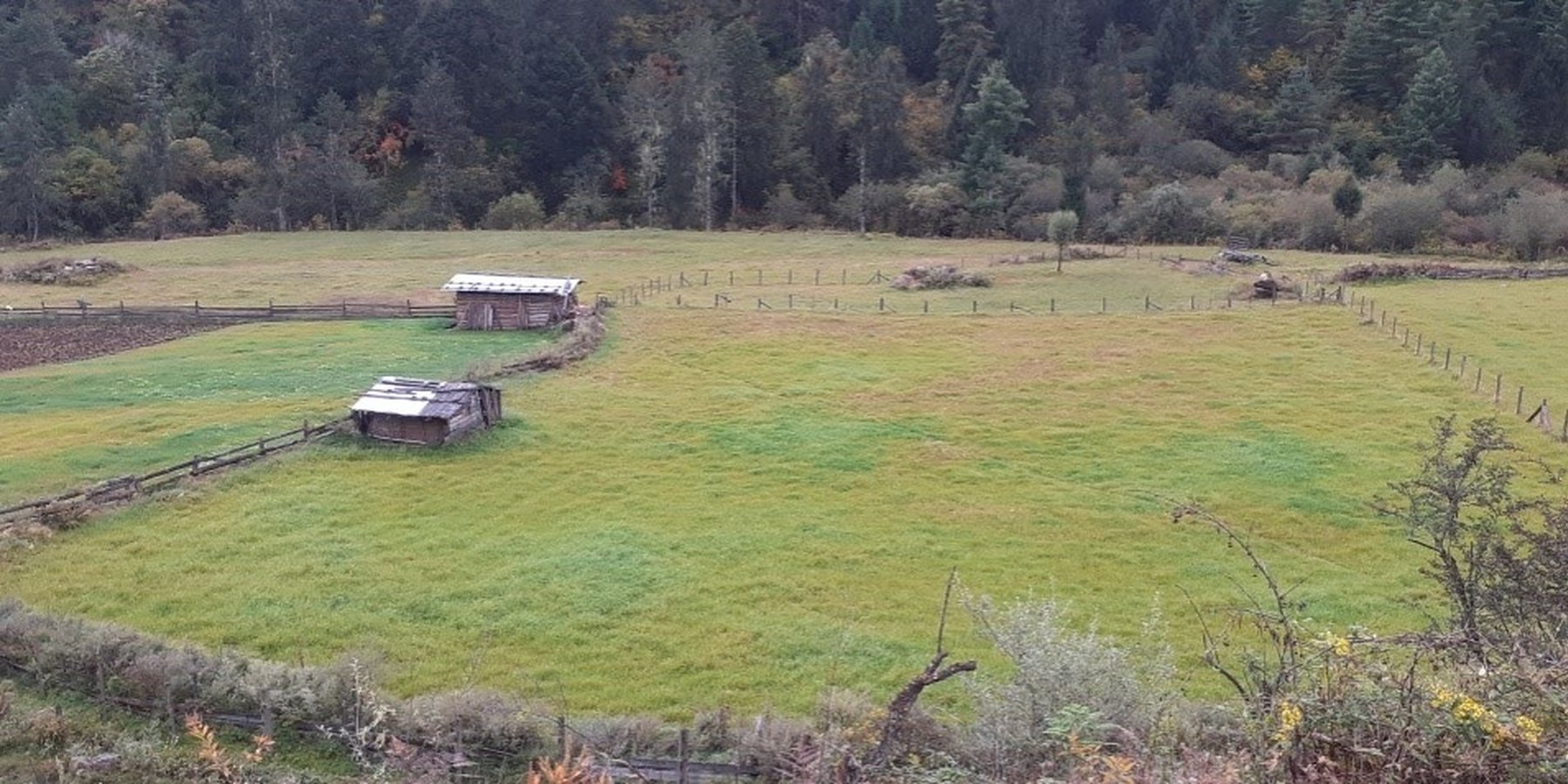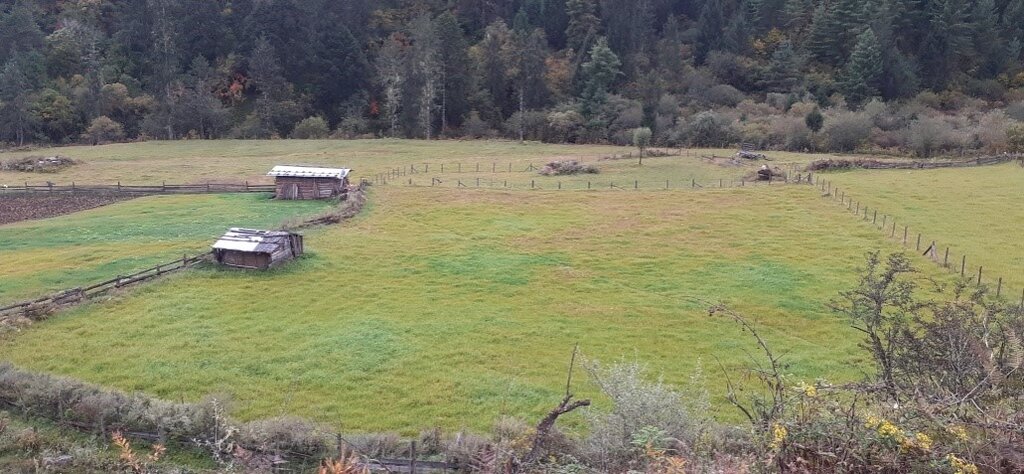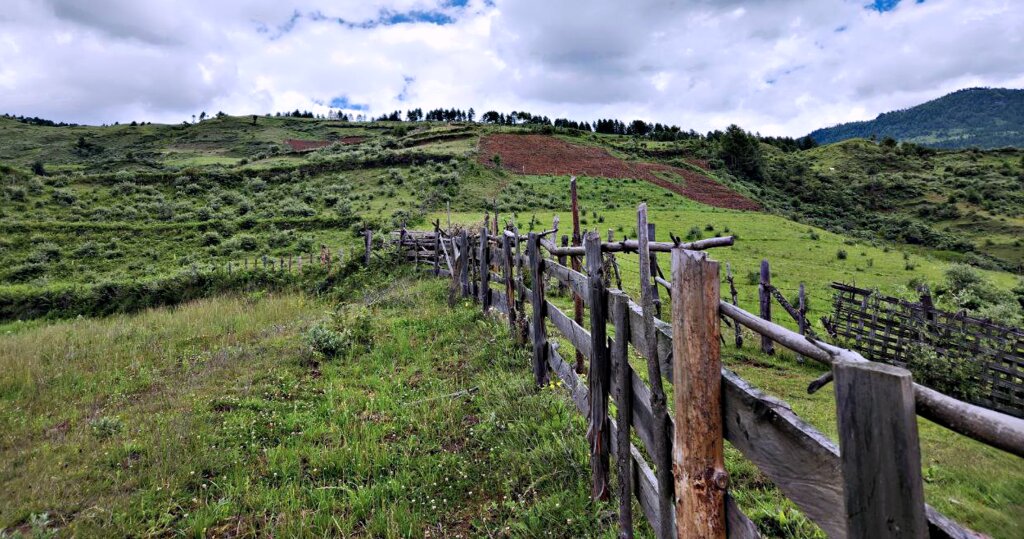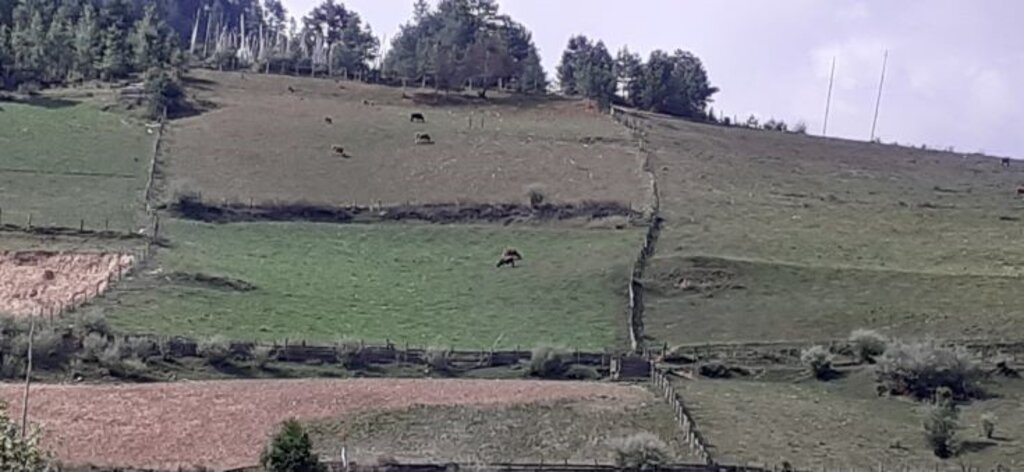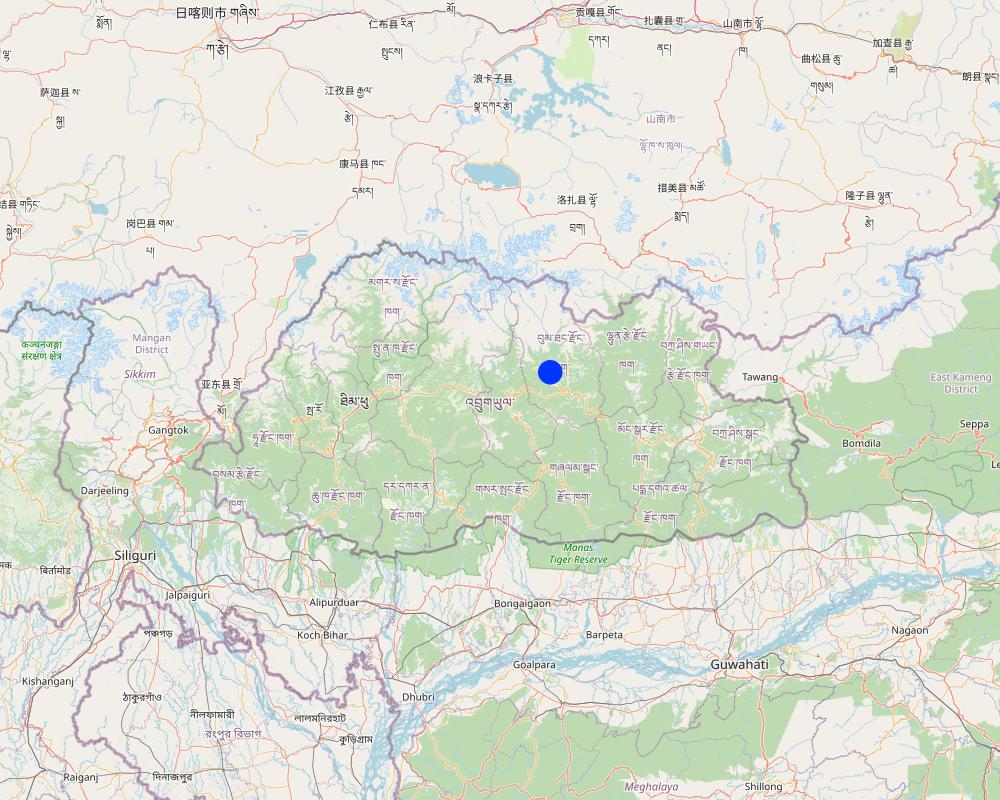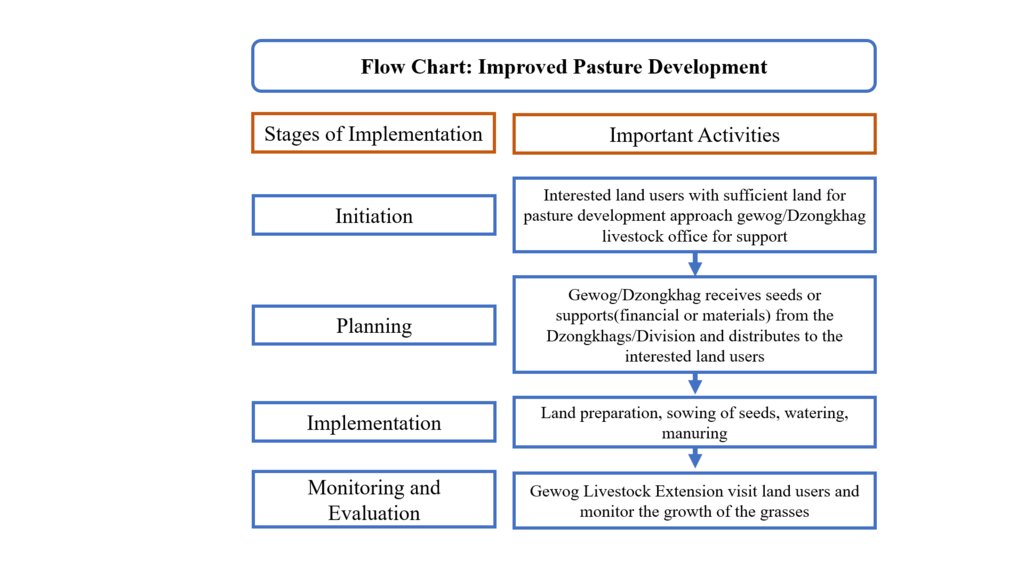Improved Pasture Development [Bhutan]
- Creation:
- Update:
- Compiler: ONGPO LEPCHA
- Editor: Haka Drukpa
- Reviewers: William Critchley, Rima Mekdaschi Studer
Tsamdro Gongphel (ཙྭ་འབྲོག་གོང་འཕེལ།)
approaches_6858 - Bhutan
View sections
Expand all Collapse all1. General information
1.2 Contact details of resource persons and institutions involved in the assessment and documentation of the Approach
Key resource person(s)
land user:
Baleymo
Tangbi community
Tangbi, Choekhor Gewog (Block), Bumthang Dzongkhag (District), Bhutan
Bhutan
land user:
Choden Sonam
+97517670437
Tangbi community
Tangbi, Choekhor, Bumthang, Bhutan
Bhutan
land user:
Wangmo Phurpa
+97517951687
Tangbi community
Tangbi, Choekhor Gewog (Block), Bumthang Dzongkhag (District), Bhutan
Bhutan
Name of project which facilitated the documentation/ evaluation of the Approach (if relevant)
Strengthening national-level institutional and professional capacities of country Parties towards enhanced UNCCD monitoring and reporting – GEF 7 EA Umbrella II (GEF 7 UNCCD Enabling Activities_Umbrella II)Name of the institution(s) which facilitated the documentation/ evaluation of the Approach (if relevant)
National Soil Services Centre, Department of Agriculture, Ministry of Agriculture & Livestock (NSSC) - Bhutan1.3 Conditions regarding the use of data documented through WOCAT
When were the data compiled (in the field)?
19/07/2023
The compiler and key resource person(s) accept the conditions regarding the use of data documented through WOCAT:
Yes
2. Description of the SLM Approach
2.1 Short description of the Approach
The improved pasture development approach focuses on enhancing pasture productivity, which is managed sustainably for grazing. Livestock productivity depends greatly on improved pastures. It is very important to manage pastures to support the livelihoods of rural communities in Bhutan.
2.2 Detailed description of the Approach
Detailed description of the Approach:
The improved pasture development approach in Bhutan started at the beginning of the 5th Five Year Plan (1982-1987). Thangbi village, Bumthang, focuses on enhancing pastureland productivity and sustainability through the cultivation of improved varieties of grasses provided by the project. This initiative not only prevents land degradation and erosion but also enhances fertility by introducing leguminous species like clover. In temperate areas, improved pasture consists of a mixture of white clover, tall fescue, cocksfoot, and Italian ryegrass while in the subtropical areas, green leaf desmodium, molasses grass (Melinis sp.), ruzi grass (Brachiaria sp.), and stylo are grown.
Given the significant role livestock plays in the livelihood of Bhutanese communities, where productivity is strongly influenced by seasonal variations in fodder availability, improved pasture development addresses crucial objectives. These are: 1) Enhancing the resilience of pasture ecosystems to ensure continuous, high-quality fodder production; 2) Increasing forage availability and quality by promoting the cultivation of improved fodder species; and 3) Improving livestock productivity, directly impacting income generation through increased yields of animal products - especially of milk, cheese, and butter.
Implementation involves four stages: 1) Initial assessments of pasture conditions and land suitability, conducted by livestock extension officials; 2) Planning sessions involving officials from the Department of Livestock and land users; 3) Establishment of the identified areas for growing improved fodder species; and 4) Management of improved pasture plots by land users, accompanied by regular monitoring and evaluation to ensure effectiveness.
Key stakeholders in this approach include livestock extension agents and community members. Livestock extension agents act as a liaison between the community and the government. They also procure and distribute fodder grass seeds. Community members establish pastures in their farms, taking on responsibilities such as monitoring the water supply and caring for the grasses throughout their growing seasons.
Land users appreciate the approach because it ensures abundant fodder availability year-round, improving milk production through the cultivation of superior grass species, and reducing the workload associated with foraging in forests or tending grazing cows. However, concerns raised by land users include a reduction in cultivable land due to fodder grass cultivation and a lack of training regarding fodder management for those involved in the approach.
2.3 Photos of the Approach
2.5 Country/ region/ locations where the Approach has been applied
Country:
Bhutan
Region/ State/ Province:
Bumthang Dzongkhag (District)
Further specification of location:
Thangbi Village, Choekhor Gewog (Block)
Map
×2.6 Dates of initiation and termination of the Approach
Indicate year of initiation:
1980
Comments:
The pasture grass seeds are provided to the community members annually free of cost and this approach is continuing until the present.
2.7 Type of Approach
- project/ programme based
2.8 Main aims/ objectives of the Approach
1) Enhance the resilience of pasture ecosystems: For countries like Bhutan, fodder production is largely affected by season and during off season, the productivity goes down drastically, leaving many land users in distress. Therefore, improved pasture development enables land users to continuously harvest quality fodder for their cows.
2) Increase forage availability and quality: The improved pasture development approach not only focuses on the production of fodder in quantity but also the quality by encouraging land users to grow improved varieties of fodder species.
3) Improve livestock productivity: Improving productivity is the primary objective as it directly connects to the quantity of animal produce like milk, cheese, butter, etc., that affects the income generated.
2.9 Conditions enabling or hindering implementation of the Technology/ Technologies applied under the Approach
social/ cultural/ religious norms and values
- enabling
Community members/land users shared the same social, cultural, and religious norms and values. Implementation of any project didn't have any issues.
availability/ access to financial resources and services
- enabling
Community members/land users are provided with improved varieties of fodder grass for free based on the area of the land.
institutional setting
- enabling
The improved pasture development has helped improve the livelihood of the community members.
knowledge about SLM, access to technical support
- hindering
The land users know that pasture development is directly related to SLM, however land users didn't receive any trainings on the improved pasture development through the approach.
workload, availability of manpower
- enabling
The workload has relatively decreased: In the past, community members had to go to the forest to either collect fodder or look after cow that graze on the grasses, but now pasture grass is readily available.
3. Participation and roles of stakeholders involved
3.1 Stakeholders involved in the Approach and their roles
- local land users/ local communities
Community members
Receive the fodder grass seeds and establish pasture lands in their registered lands. He/she also monitors the water requirement and takes care of the grasses throughout its growing seasons.
- Department of Livestock, Ministry of Agriculture and Livestock
Livestock extension agent
The livestock extension agent act as a bridge between the community and the governments. He/she handles the project at the grassroots level by meeting and discussing improved pasture development personally with the interested land users. He/she is responsible for procuring the seeds of fodder grasses and distributing them to the community members.
3.2 Involvement of local land users/ local communities in the different phases of the Approach
| Involvement of local land users/ local communities | Specify who was involved and describe activities | |
|---|---|---|
| initiation/ motivation | passive | Livestock extension agent upon consultation with research centers will carry out initial assessments of pasture conditions (which species of pasture grass species to be grown) and land suitability study. |
| planning | interactive | The livestock extension agent and the community members decided on how to establish and implement the project. |
| implementation | self-mobilization | In the initiation phase grass species are already identified and once planning is done. Land users will be provided seeds and they have to establish the pasture on their own. |
| monitoring/ evaluation | self-mobilization | Monitoring of pasture field is normally done by the community members, and ocasionally it is monitored by the extension for scheduled reporting purpose. |
3.3 Flow chart (if available)
Description:
The flow chart was created based on the information provided by the community members.
Author:
Ongpo Lepcha
3.4 Decision-making on the selection of SLM Technology/ Technologies
Were decisions on the selection of the Technology(ies) made:
- Livestock extension agent
Explain:
The livestock extension agent in consultation with relevant agencies procure and supply pasture grass seeds to interested farmers for pasture development.
- Consultation with research centers
4. Technical support, capacity building, and knowledge management
4.1 Capacity building/ training
Was training provided to land users/ other stakeholders?
No
4.2 Advisory service
Do land users have access to an advisory service?
Yes
Specify whether advisory service is provided:
- on land users' fields
Describe/ comments:
Whenever community members require any sort of technical assistance or advisory services, Livestock Extension agent at their capacity provides the support. however, if higher intervention is required EA solicit supports from the dzongkhag, Central programs and the department of livestockand accordingly provide assistance.
4.3 Institution strengthening (organizational development)
Have institutions been established or strengthened through the Approach?
- yes, a little
Specify the level(s) at which institutions have been strengthened or established:
- local
Describe institution, roles and responsibilities, members, etc.
The livelihood of the community has been relatively better with the improved pasture development.
- Planting materials
Give further details:
The extension agent would provide improved pasture grass seeds based on the availability of budget for seeds procurement.
4.4 Monitoring and evaluation
Is monitoring and evaluation part of the Approach?
Yes
Comments:
Monitoring is mostly done by the community members.
If yes, is this documentation intended to be used for monitoring and evaluation?
No
4.5 Research
Was research part of the Approach?
No
5. Financing and external material support
5.1 Annual budget for the SLM component of the Approach
If precise annual budget is not known, indicate range:
- 10,000-100,000
Comments (e.g. main sources of funding/ major donors):
The funding is mostly in terms of cost of the improved pasture grass varieties.
5.2 Financial/ material support provided to land users
Did land users receive financial/ material support for implementing the Technology/ Technologies?
No
5.3 Subsidies for specific inputs (including labour)
- none
5.4 Credit
Was credit provided under the Approach for SLM activities?
No
5.5 Other incentives or instruments
Were other incentives or instruments used to promote implementation of SLM Technologies?
No
6. Impact analysis and concluding statements
6.1 Impacts of the Approach
Did the Approach help land users to implement and maintain SLM Technologies?
- No
- Yes, little
- Yes, moderately
- Yes, greatly
No workshop or tainings were provided to the community members, however, they relied on their traditional knowledge on pasture land management.
Did the Approach improve knowledge and capacities of land users to implement SLM?
- No
- Yes, little
- Yes, moderately
- Yes, greatly
Community members relied on their traditional knowledge about pasture grass management
Did the Approach build/ strengthen institutions, collaboration between stakeholders?
- No
- Yes, little
- Yes, moderately
- Yes, greatly
The livelihood of the community has relatively improved compared to the past.
Did the Approach empower socially and economically disadvantaged groups?
- No
- Yes, little
- Yes, moderately
- Yes, greatly
All the households in the community irrespective of their background were provided with the pasture grass seeds.
Did the Approach improve gender equality and empower women and girls?
- No
- Yes, little
- Yes, moderately
- Yes, greatly
All genders were equally encouraged to participate
Did the Approach lead to improved food security/ improved nutrition?
- No
- Yes, little
- Yes, moderately
- Yes, greatly
The cultivated land has decreased due to the improved pasture land
6.2 Main motivation of land users to implement SLM
- increased production
The introduction of improved pasture grass, has helped improve dairy production in the community
- reduced risk of disasters
Forest grazing is reduced, resulting to less incidence of human wildlife conflict (livestock depredation)
- reduced workload
Since pasture grass is cultivated nearby the workload has decreased
6.3 Sustainability of Approach activities
Can the land users sustain what has been implemented through the Approach (without external support)?
- uncertain
If no or uncertain, specify and comment:
The community member were unsure about its sustainability due to several factors such as rural urban migration and so on.
6.4 Strengths/ advantages of the Approach
| Strengths/ advantages/ opportunities in the land user’s view |
|---|
| Reduced workload |
| Fodder available in large amount |
| Higher milk production |
| Strengths/ advantages/ opportunities in the compiler’s or other key resource person’s view |
|---|
| Reduction of surface runoff |
| Increase fertility of the soil |
6.5 Weaknesses/ disadvantages of the Approach and ways of overcoming them
| Weaknesses/ disadvantages/ risks in the land user’s view | How can they be overcome? |
|---|---|
| Reduction in cultivated land | |
| Land users have to depend on livestock officers for seeds | Training on seed production can be given to enhance their skills |
7. References and links
7.1 Methods/ sources of information
- field visits, field surveys
One household
- interviews with land users
Three individuals
7.2 References to available publications
Title, author, year, ISBN:
Marzban, S. & Valizadeh, N. (2020). Pasture Development: Fundamentals and Managerial Perspectives.
Available from where? Costs?
https://www.researchgate.net/publication/339074876_Pasture_Development_Fundamentals_and_Managerial_Perspectives
7.3 Links to relevant information which is available online
Title/ description:
Improving the quality of pastures
URL:
https://business.qld.gov.au/industries/farms-fishing-forestry/agriculture/sustainable/graze/pasture/improve
Title/ description:
Pasture Development on Small Farms
URL:
https://farmstyle.com.au/news/pasture-development-small-farms
Title/ description:
Strategies for improving run down pastures
URL:
https://www.incitecpivotfertilisers.com.au/news-and-insights/agronomic-insights/pasture/strategies-for-improving-run-down-pastures
Title/ description:
Pasture Management: Effective Planning & Implementation
URL:
https://eos.com/blog/pasture-management/
Links and modules
Expand all Collapse allLinks
No links
Modules
No modules


